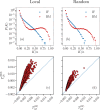Thermodynamic analog of integrate-and-fire neuronal networks by maximum entropy modelling
- PMID: 38664504
- PMCID: PMC11045794
- DOI: 10.1038/s41598-024-60117-3
Thermodynamic analog of integrate-and-fire neuronal networks by maximum entropy modelling
Abstract
Recent results have evidenced that spontaneous brain activity signals are organized in bursts with scale free features and long-range spatio-temporal correlations. These observations have stimulated a theoretical interpretation of results inspired in critical phenomena. In particular, relying on maximum entropy arguments, certain aspects of time-averaged experimental neuronal data have been recently described using Ising-like models, allowing the study of neuronal networks under an analogous thermodynamical framework. This method has been so far applied to a variety of experimental datasets, but never to a biologically inspired neuronal network with short and long-term plasticity. Here, we apply for the first time the Maximum Entropy method to an Integrate-and-fire (IF) model that can be tuned at criticality, offering a controlled setting for a systematic study of criticality and finite-size effects in spontaneous neuronal activity, as opposed to experiments. We consider generalized Ising Hamiltonians whose local magnetic fields and interaction parameters are assigned according to the average activity of single neurons and correlation functions between neurons of the IF networks in the critical state. We show that these Hamiltonians exhibit a spin glass phase for low temperatures, having mostly negative intrinsic fields and a bimodal distribution of interaction constants that tends to become unimodal for larger networks. Results evidence that the magnetization and the response functions exhibit the expected singular behavior near the critical point. Furthermore, we also found that networks with higher percentage of inhibitory neurons lead to Ising-like systems with reduced thermal fluctuations. Finally, considering only neuronal pairs associated with the largest correlation functions allows the study of larger system sizes.
© 2024. The Author(s).
Conflict of interest statement
The authors declare no competing interests.
Figures

















Similar articles
-
Ising-like model replicating time-averaged spiking behaviour of in vitro neuronal networks.Sci Rep. 2024 Mar 25;14(1):7002. doi: 10.1038/s41598-024-55922-9. Sci Rep. 2024. PMID: 38523136 Free PMC article.
-
The number of synaptic inputs and the synchrony of large, sparse neuronal networks.Neural Comput. 2000 May;12(5):1095-139. doi: 10.1162/089976600300015529. Neural Comput. 2000. PMID: 10905810
-
Nonequilibrium dynamics of random field Ising spin chains: exact results via real space renormalization group.Phys Rev E Stat Nonlin Soft Matter Phys. 2001 Dec;64(6 Pt 2):066107. doi: 10.1103/PhysRevE.64.066107. Epub 2001 Nov 14. Phys Rev E Stat Nonlin Soft Matter Phys. 2001. PMID: 11736236
-
Structural determinants of criticality in biological networks.Front Physiol. 2015 May 8;6:127. doi: 10.3389/fphys.2015.00127. eCollection 2015. Front Physiol. 2015. PMID: 26005422 Free PMC article. Review.
-
Electric field-induced effects on neuronal cell biology accompanying dielectrophoretic trapping.Adv Anat Embryol Cell Biol. 2003;173:III-IX, 1-77. doi: 10.1007/978-3-642-55469-8. Adv Anat Embryol Cell Biol. 2003. PMID: 12901336 Review.
References
-
- Dayan, P. & Abbott, L. F. Theoretical Neuroscience: Computational and Mathematical Modeling of Neural Systems (The MIT Press, 2005).
-
- Little WA. The existence of persistent states in the brain. Math. Biosci. 1974;19:101–120. doi: 10.1016/0025-5564(74)90031-5. - DOI
Grants and funding
LinkOut - more resources
Full Text Sources
Miscellaneous

